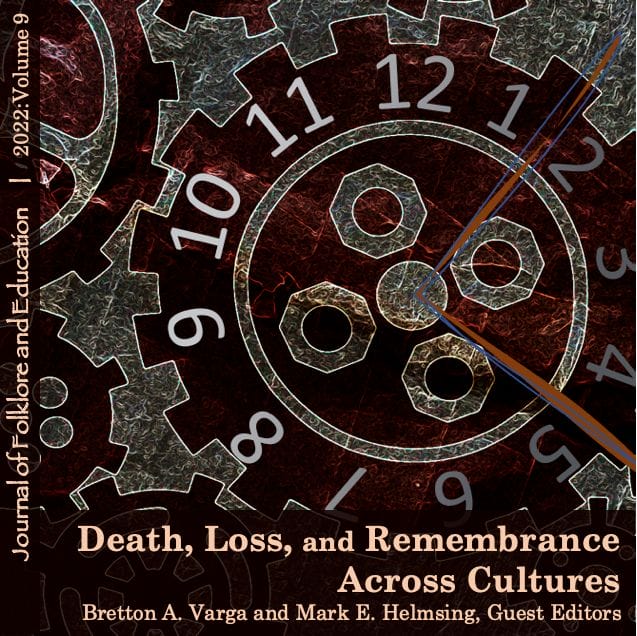By Bretton A. Varga and Mark E. Helmsing, Guest Editors
Grief and loss can help learners consider conditions that contribute to the (re)shaping of how we should feel about losses of life within/outside our cultural worldviews, especially when such losses animate many lessons and topics in our curricula, from war and genocide to colonialism and imperialism to epidemics and natural disasters.
By Cory Wright-Maley
Critiquing the notion of time as consistent, linear, and calculable, the author calls upon social studies teachers to rethink and expand how we teach with and about time.
By Ashley Minner
This article includes Classroom Connections.
“Baltimore is totally haunted,” Ashley Minner writes. “Every absence points to a presence.” Using maps, family stories, and place-based research, Minner explores her American Indian community in Baltimore to counter erasure from the landscape and from public memory.
By Browning Neddeau
Exploring the poem as conversation with his grandmother who has walked on, the author invites readers to explore “Gnimedimen [We Dance]” and think of their ancestors. He asks: “If you could ask your ancestors one question, what would it be?”
By Bretton A. Varga and Kevin J. Burke
This interview explores secular concepts and religious frameworks, ranging from themes of transcendence and religious traditionality to how visual ethnography (PhotoVoice) might be a productive tool for spatial engagement with death, loss, and remembrance.
By Biaohua Lei
This article includes Classroom Connections.
Using a multiyear vertical curriculum model, this teacher presents the history and traditions of the Tomb Sweeping Festival—清明节 Qing Ming Jie—to engage instructional topics on traditions about death, as well as remembrance, and the worldview values they reinforce.
By Ofelia Esparza
This article includes Classroom Connections.
As Día de los Muertos celebrations grow ever more popular, this article shares a perspective grounded in the East L.A. Chicano community from National Heritage Fellow Ofelia Esparza. A former school teacher, her classroom activities offer teachers important resources and lessons.
By Kimi Eisele
This article includes Classroom Connections.
The Tucson Meet Yourself Folklife Festival’s Loss and Remembrance Tent gave participants a place to feel what they were feeling, to recognize the reality of loss through their own visceral experience, and to acknowledge and make space for the weight of death and remembrance.
By Kaitlyn L. Kinney
This brief survey of thanatological social movements offers a potential starting point for researching the U.S. deathscape and, for educators, four resources that can be incorporated into classroom work.
By Amy Mungur
Preservice teachers must navigate the challenges of U.S.-centered representations that extend beyond textbooks and other curricular materials. Using Life magazine photo essays proves a particularly compelling, and powerfully instructive, source for critical analysis.
By Joe Stahlman and Hayden Haynes with Jocelyn Jones
This article includes Classroom Connections.
A photo essay and exhibition proves powerful for a community looking at the aftereffects of one Indian Boarding School.
By Joe Stahlman
This historical essay accompanies the Thomas Indian School photo essay.
By Nic Hartmann
This article includes Classroom Connections.
Derecho Days is an experimental, personal comic art piece that navigates the aftermath of a natural disaster. It reflects upon the short-term and long-term effects of this storytelling medium on the creator.
By Paddy Bowman
This activity uses a primary set source from the Library of Congress to model how documentation of the Covid-19 pandemic can amplify students’ voices.
By Elena Foulis
Using oral histories and narratives collected during the Covid-19 pandemic, a student-led performance invites consideration about the role of language, cultural, and social pluralities in creating a socially just world.
By Mark Helmsing with Derek Piotr
This interview underscores a commitment in teaching and research to better understand how people feel about the past and how the past makes people. Music, recorded sounds, and recollected memories become rich and vibrant materials for feeling the past.
By John P. Doucet, Annie Doucet, and Windell Curole
Natural disasters, like hurricanes, are great forces that enter and alter people’s lives as well as their perceptions of reality. This article offers a model for community education events based on history, culture, and lore using the centennial of the Great October Storm of 1893 in Louisiana as a case study.
By Rick Fisher and Maggie Bourque
This article includes Classroom Connections.
Examining how the solace of “home” is undercut with anxiety and—for many more—grief, the authors consider how folklore education can fill an important gap in present cultural engagement with climate change.
By Martha Sims, Timothy H. Evans, Mary L. Sellers, Julián Antonio Carrillo, Kennedi Johnson
Reviews of: Advancing Folkloristics. Jesse A. Fivecoate, Kristina Downs, and Meredith A. E. McGriff, eds.
* What Folklorists Do: Professional Possibilities in Folklore Studies. Timothy Lloyd, ed.
* Critical Perspectives on Teaching in the Southern United States. Tori K. Flint and Natalie Keefer, eds.
* Theorizing Folklore from the Margins: Critical and Ethical Approaches. Solimar Otero and Mintzi Auanda Martínez-Rivera, eds.
* Engaging the African Diaspora in K-12 Education. Kia Lilly Caldwell and Emily Susanna Chávez, eds.
 Death, Loss, and Remembrance prompts readers to consider their own complex and complicated relationship(s) to death and contemplate how people come to understand themselves, each other, and the world around them. Folklore can be a resource in helping heal from the trauma of loss and death while also aiding ongoing efforts to reckon with historical trauma from our shared histories. Such healing and reflection can occur through cultural practices of remembrance and the building of educational practices that promote temporal literacy.
Death, Loss, and Remembrance prompts readers to consider their own complex and complicated relationship(s) to death and contemplate how people come to understand themselves, each other, and the world around them. Folklore can be a resource in helping heal from the trauma of loss and death while also aiding ongoing efforts to reckon with historical trauma from our shared histories. Such healing and reflection can occur through cultural practices of remembrance and the building of educational practices that promote temporal literacy.
